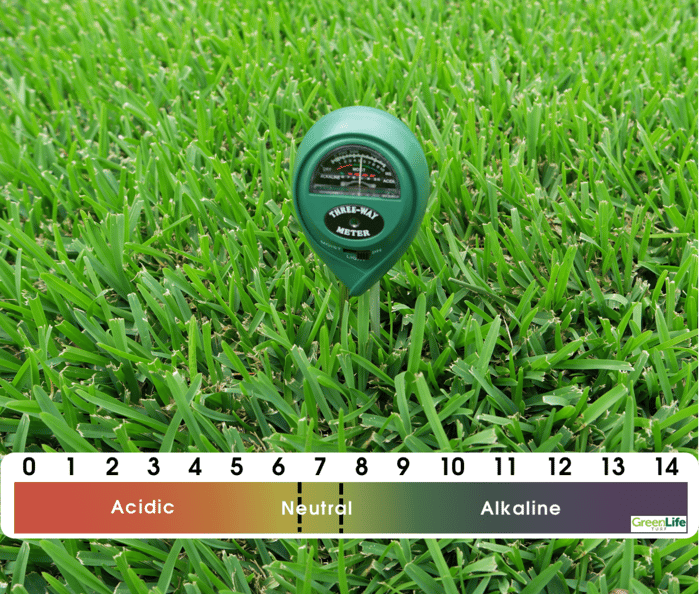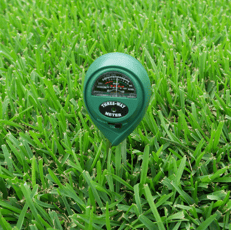
We’ve been talking about fertiliser over the last few weeks; what it is, how it works, and why it’s important. So it won’t come as a surprise to you to know that the quality of your soil plays a vital role to all vegetation. From flowers and plants, trees and shrubs, to fruits and vegetables, to your lawn, if your soil is not providing the right balance of nutrients, your vegetation simply will not thrive.
So how do you know? How can you test the quality of your soil? And what even is soil pH?!
Let's explore it all and see how you can get your own, reusable, accurate testing tool!
What is Soil pH?
Soil pH is the measurement of the acidity and alkalinity in – well – your soil. Taking you back to high school chemistry for a minute, pH levels range from 0 to 14, with:
- 7 being neutral,
- The lower the number the more acidic, and
- The higher the number the more alkaline.
Like this:

Why is Soil pH Important?
First up, you need to know that all plant life need specific amounts of nutrients to both survive and flourish. Major nutrients are often referred to as NPK (Nitrogen (N), Phosphorus (P), Potassium (K), and there are a variety of minor nutrients like Magnesium and Calcium.
Secondly, plant roots are only able to absorb liquid, so they need to be able to get these nutrients from the soil in liquid form. That means nutrients need to be dissolved in water (through rain or watering) to be able to absorb them.
Finally, nutrients can only be dissolved in water if the pH is right, making soil pH is a key influencer in the absorption of these nutrients by plants. If the pH is out, these nutrients become unavailable to your plants – imagine physically you could only drink liquids for your nutrients (food), but you were only ever served steak…
Soil pH Variants
There’s no magical guide or visual clues to what any given soil's pH is. The pH of cultivated soils can be very different, and different again to the native soil, so the use of developed soils over time and the transference of vegetation will play a big part in the varying pH of soils, even between next door neighbours!
Environmental factors on pH include rainfall and temperatures. Speaking very generally, the heavier the rainfall the more acidic you will find native soil to be.
 How to Test Soil pH
How to Test Soil pH
You can buy disposable pH soil testing kits from local stores like Bunnings, and with a little mixing and careful comparison, you can get a reading on your soil’s pH. Better yet, you can get your own reusable pH tester from us (see image to the right) - accurate readings, no fuss, no mess, no guess work! We’ve just finished testing the product and have a shipment on its way.
Want us to notify you when it comes available? Simply click the image and add your name to our notification list!
What’s Wrong with My Soil?
In simple terms:
- If your soil is too acidic, it has major nutrient deficiencies.
- If your soil is too alkaline, it has trace element deficiencies.
It’s worth noting, just as humans have different preferences, so do plants. Some like more acidity, while others like it a little more alkaline! It’s important to know both what your soil offers and how to adjust it if it’s not right for the vegetation you want to grow.
How to Fix Soil pH
Most vegetation like a pH range of 6-7 (natural or slightly acidic), but there are exceptions and it’s important to know what you’re planning to grow likes best. If you’re using store-bought products, always follow the directions carefully.
- Lowering Soil pH –
That means your soil pH is high which means it’s alkaline, and you will be lowering your soil pH towards neutral.
To do this you will need to add acid. You can do this using sulphur, pine needles, shredded leaves or even sawdust. - Increasing Soil pH –
That means your soil pH is low and therefore acidic and you need to increase your soil pH towards neutral.
To do this you need to add lime. Ground limestone breaks down slowly and should not burn plants if applied following the instructions. Dolomite is also useful as it contains higher magnesium levels which acidic soils tend to be deficient in.
Another way increase to pH is to apply wood ashes which contains calcium carbonate, potassium, phosphorus and a variety of other trace elements. But be careful here as a little goes a long way.
Do I Still Need to Fertilise?
Yes. pH levels play a crucial role by dissolving the nutrients into liquid form. Fertilising ensures the right levels of each nutrient - each major element, each minor element - is there to be dissolved and aborbed! You can also check out our information on fertiliser types here.














